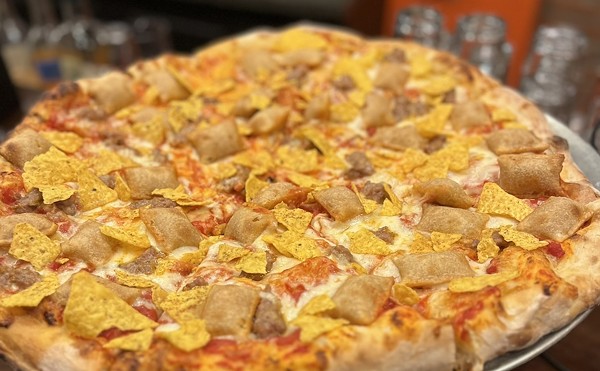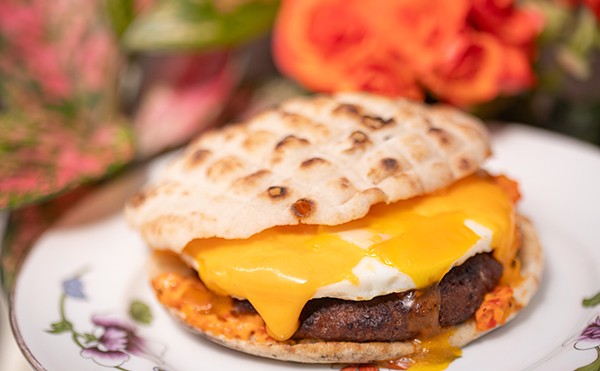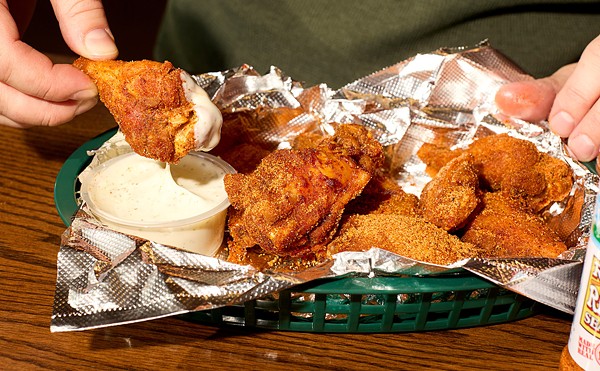Smith & Slay's is on the second floor of Clayton on the Park, a new "vertical neighborhood" of apartments and hotel rooms overlooking Shaw Park. During the months before the restaurant's opening, rumors about its theme abounded. The restaurant's planners needed to solve a demographic problem: How could they appeal to the young professionals who are the bread-and-butter of the Clayton restaurant scene without turning off the wealthy older patrons who would live at Clayton on the Park? Their clever solution was to model Smith & Slay's after the supper clubs of the 1940s and '50s. Slay, who once owned a restaurant in Beverly Hills, might have had in mind Perino's on LA's Wilshire Boulevard, or maybe the old Hollywood celebrity hangouts the Trocadero and Ciro's.
The supper-club trend began in the late '90s as cigars, swing dancing and classic cocktails came into vogue. Places such as Club Lucky and the Moonlight Cafe in Chicago, Aces Supper Club in Sacramento and Parker's Bar in Boston are pulling off this theme with pizzazz and hauling in the box-office receipts. The National Restaurant Association reports that old-fashioned menu items such as vichyssoise, Caesar salad and Dover sole have surged in popularity. The idea is kitschy enough to draw the chic crowd, yet it's familiar to older patrons who remember smoking Lucky Strikes and dancing to big-band sounds at cabarets such as New York City's Rainbow Room.
The supper-club concept is carried through in every detail, beginning with service. Each waiter sports a blue tie whose tail is tucked into his marine-blue shirt with a natty half-twist, the way a WW II soldier wore his uniform. Instead of delivering plates by hand or lugging tray jacks, like waitresses at the IHOP, the waiters wheel around their plates, condiments and supplies on silver guéridons, or trolleys. We generally don't care for dining-room theatrics -- cooking and saucing should be done in the kitchen -- but the waiters do perform a few tableside maneuvers, such as deboning the Dover sole.
Every detail in the dining room has been as carefully selected as a prop on a movie set. Like the servers' uniforms, the room is gussied up in shades of sapphire, with accents of frosted glass and almost reddish wood paneling. The colossal overhead lighting fixtures are crafted from telescoping ivory lampshades, with each of the inner hoops hanging a bit lower than the one around it. The high-backed, crescent-shaped banquettes along the interior wall are intimate enough for a romantic date or an anniversary dinner. Most of the tables are covered with crisp white cloths and set with striking cobalt-glass charger plates. The tables in the center row of booths are left bare to expose their spiffy blue finish. Near the French doors, freestanding tables are accompanied by angular chairs upholstered in an indigo fabric randomly dotted with circles, like fizz in a Champagne glass.
The "Bon Bar" in the restaurant's name is a neo-hipism coined in homage to the old Bonhomme Hotel, which was razed to make way for Clayton on the Park. The bar itself is shaped something like one of those staples with a kink in it. The nifty barstools have a spiky silhouette that tapers from the small round seats to the tiny chrome footrest that encircles the stem. Overstuffed chairs clustered here and there create the easygoing mood of a private cocktail party. The overall look falls somewhere between Starbucks and The Jetsons.
Most of the menu complements the supper-club theme, but a few dishes break formation. The most innovative item on the menu is also the most artfully presented: a cone slipped into a form-fitting coil that looks as though it might be part of a Harley's exhaust system. To make it, a wonton skin is placed in the coil mold and baked until brittle. Then the cone is filled with finely diced salmon tartare mixed with Thai chiles, scallions and mayonnaise. It's garnished with radish sprouts, chives and silvery-gray osetra caviar. Such savory cones, first conceived by chef Thomas Keller at his famed Napa Valley restaurant the French Laundry, were all the rage on the West Coast a couple of years ago.
Many of the dishes on the menu are retro favorites featuring classic flavor combinations. As a first course, we opted for a salad of roasted pears and mesclun charmingly tied into a bundle with a ribbon of leek greens. A round of goat cheese coated with crushed pistachios has a salty, racy tang that underscores the pear's sweetness. Shrimp "fritters" turned out to be merely fried shrimp served with a spicy scallion mayonnaise. We were disappointed -- until we tried them, that is. We were so keen on the delectable, airy little morsels that we couldn't stop eating them. Our final choice from the appetizer list was bacon-wrapped scallops. Slay updates this traditional pairing with mild applewood-smoked bacon, giving the dish an earthy edge that punctuates the scallops' briny flavor.
As our appetizers demonstrated, Slay knows his way around seafood. The best evidence was an evening special of Chilean sea bass. Now, food writers almost invariably describe fish as "moist, tender and flaky" if they like it. This fish did not flake. Instead, with the merest tap of the fork on its seared surface, glistening shingles of pearly flesh slid from the puffy mound. The fillet rested in a shallow pool of tomato coulis, with a few dried tomatoes scattered atop the fish. The bright acidity of the sauce and the garnish was an ideal counterpoise for the rich blandness of the fish. Buttered snap peas and a cushion of blue-cheese mashed potatoes quietly rounded out the plate. Like a movie with a message, this was a dish we kept thinking about when we left the restaurant.
Among the entrées, Slay devotes an entire section to steaks and chops, which are among the most expensive main courses. We opted for two double lamb chops grilled medium-rare. All menu items are priced fairly, but we think the other main-dish choices are a better value. The pan-fried chicken breast stuffed with goat cheese, for instance, was half the price of the lamb chops. A scoop of mashed potatoes had been flattened and raked across the plate, like sand in a Japanese garden. What the presentation lacked in color, it made up in crispness and flavor.
Smith and Slay's offers a section of side dishes, a win-win menu feature that gives customers more choices while boosting check averages for the owners. The plush macaroni and cheese, made with sharp Vermont cheddar, has a delicate crust of toasted breadcrumbs. The small crock of sweet-corn pudding reminds us of that casserole dish someone always brings to the family reunion. Consider ordering a couple of sides in place of the pricey appetizers, which range from $8-$14.
Slay's dessert menu, designed by pastry chef Kate Baltz, scores high on originality. It doesn't even include crème brûlée, which has become about as obligatory in upscale restaurants as nudity is in films. A marvy selection of cookies was presented with chocolate and vanilla dipping sauces. The deep-dish banana-cream pie is probably the best we've ever tasted. It's embellished with whipped cream piped into orderly rows of starbursts. But the real beaut is Baltz's new-and-improved Hostess-style cupcake, split and filled with sweetened mascarpone cheese and glazed with shiny chocolate ganache. The only thing missing is the white string of curlicues across the top. Now, how are diners supposed to put away several of Slay's swell dishes and still have room for cookies, cakes and pies? Go crazy, folks, go crazy.





